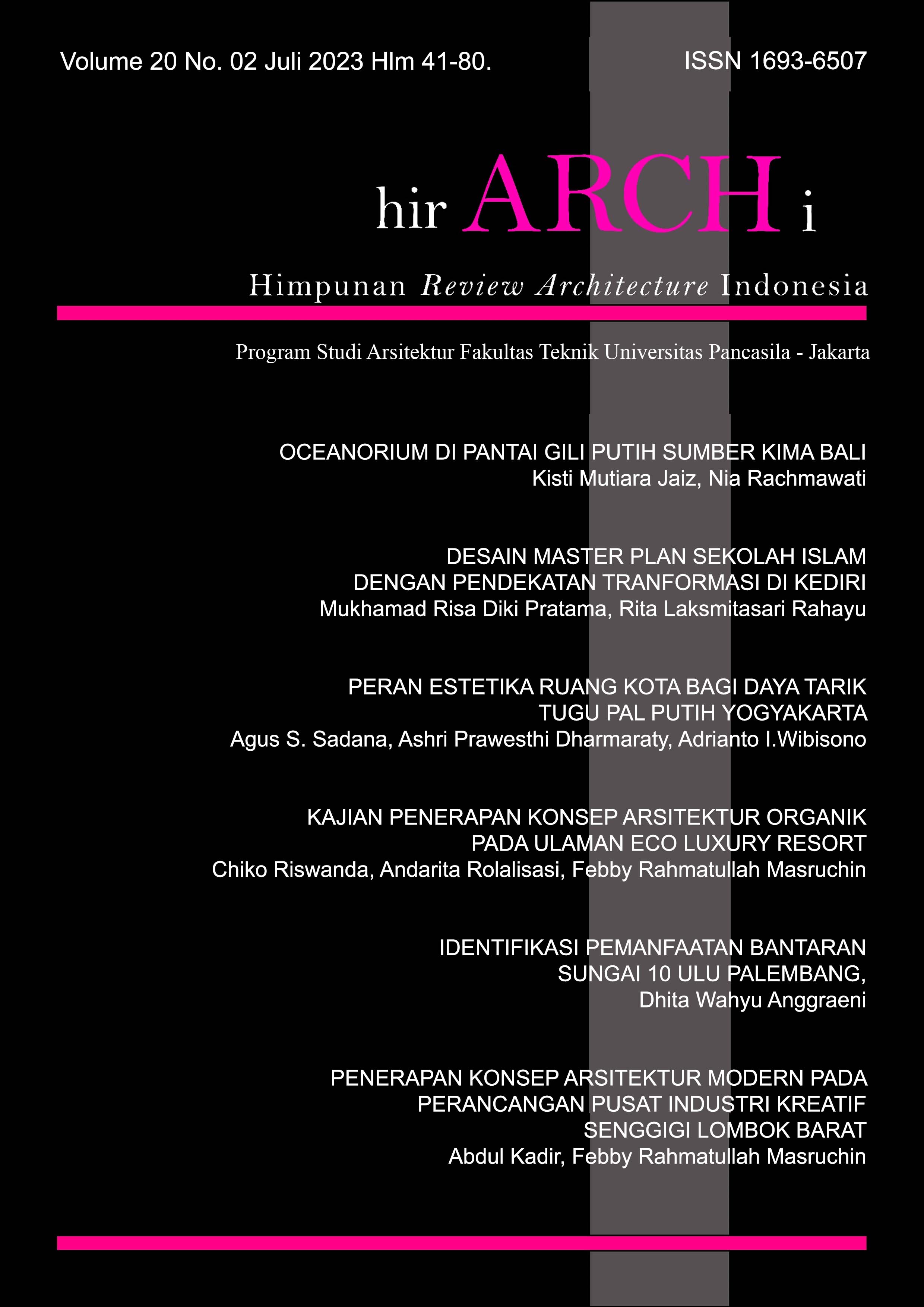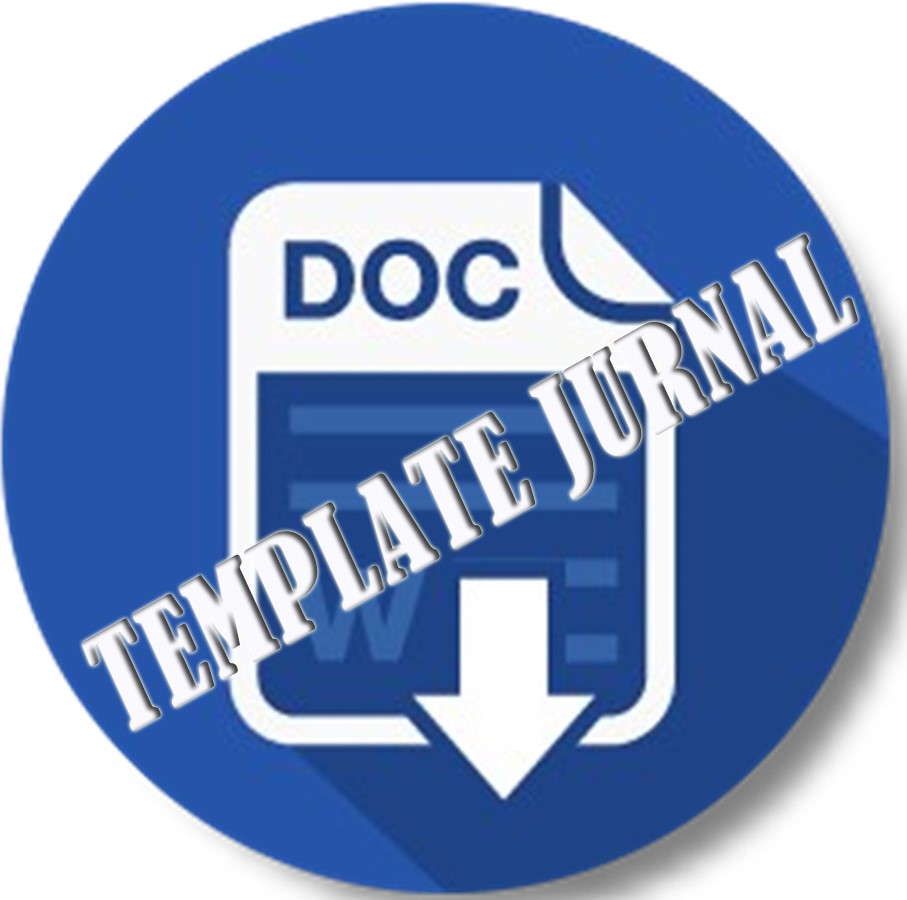PERAN ESTETIKA RUANG KOTA BAGI DAYA TARIK TUGU PAL PUTIH YOGYAKARTA
Abstract
The Tugu Pal Putih in Yogyakarta is better known as Tugu. The aesthetics of the Tugu area are essential aspects of urban space design in the role of the Tugu as part of Yogyakarta's philosophical axis. This area has four corridors: the north, south, west, and east. The environmental situation shows that the visual quality in the four corridors of the Tugu area is still not good but can play a role in strengthening the Tugu monument as the focal point. This study analyzes the Tugu area aesthetics in three aspects: visual quality, magnificence, and attractiveness. In general, the visual quality of the Tugu area feels good enough when the observer is in the eastern corridor, adequate in the northern and southern, and low enough in the western. The visualization of movement from outside to the center shows that the highest attractiveness is when the observer views the center from the north side and the lowest from the east side. In addition, the observer feels that the east corridor is rather magnificent and less in the other three. The final study result shows that the corridorscape's magnificent level has a significant role in the attractiveness level of the center. Finally, the more glorious the corridor's visual situation will reduce the center's attractiveness; on the contrary, the simpler it will increase its attractiveness.
References
Karaton Ngayogyakarta Hadiningrat, “Tugu Golong Gilig Setelah Gempa 1867,” 2018. https://www.kratonjogja.id/tata-rakiting/11-tugu-golong-gilig-simbol-persatuan-raja-dan-rakyat/.
L. E. Prasetya and W. Dharma, “Re-Emphasize Urban Linkage Continuity As An Effort For Conservating Panggung Krapyak Yogyakarta,” in International Seminar The Knowledge City: Spirit, Character and Manifestation, 2007, pp. 142–153, [Online]. Available: https://123dok.com/document/myjkp6ql-proceedings-international-seminar-knowledge-city-spirit-character-manifestation.html.
A. S. Sadana, “Kawasan Tugu Sebagai Penanda Tempat Wilayah Permukiman Kota Yogyakarta,” Jakarta, 2021. [Online]. Available: https://perpus.univpancasila.ac.id/index.php?p=show_detail&id=126965.
K. Lynch, The Image of The City. Cambridge: MIT Press, 1960.
E. Purwanto, “Pendekatan Pemahaman Citra Lingkungan Perkotaan,” Dimens. Tek. Arsit., vol. 29, no. 1, pp. 85–92, 2001, doi: https://doi.org/10.9744/dimensi.29.1.%25p.
A. P. Jati, “Environmental Quality Melalui Konsep Landmark Sebagai Citra Kota,” J. Desain Komun. Vis. dan Media Baru, vol. 3, no. 1, pp. 39–36, 2020, [Online]. Available: http://journal.unika.ac.id/index.php/tuturrupa/article/view/2985.
A. Syahbudin, S. P. Phenomenon, A. Meinata, A. S. H. Hanindita, and B. Mulyana, “City of Philosophy: Evaluation of Tree Philosophy and Its Architecture in Yogyakarta Philosophical Axis Towards UNESCO World Heritage,” in Proceeding of the 2nd International Conference on Tropical Agriculture, 2018, pp. 249–274, doi: https://doi.org/10.1007/978-3-319-97553-5.
R. Skogheim, V. K. Simon, L. Gao, and A. Dietze-Schirdewahn, “Place Identity with a Historic Landscape – An Interview-Based Case Study of Local Residents’ Relationship with the Austrått Landscape in Norway,” Herit. Soc., vol. 11, no. 1, pp. 1–18, 2018, doi: https://doi.org/10.1080/2159032X.2018.1553425.
N. Antonova, E. Grunt, and A. Merenkov, “Monuments in the Structure of an Urban Environment: The Source of Social Memory and the Marker of the Urban Space,” 2017, doi: 10.1088/1757-899X/245/6/062029.
J. M. Laurens, Arsitektur Dan Perilaku Manusia. Jakarta: Gramedia Widia Sarana, 2005.
R. C. Smardon, J. F. Palmer, and J. P. Felleman, Foundation for Visual Researc Project Analysis. New York: John Wiley & Sons, 1986.
K. A. L. H. Sari, A. Hayati, and F. T. B. Samodra, “Perception of Visual Impairment Towards the Aesthetic of Architectural Elements,” IPTEK J. Proc. Ser., no. 6, pp. 252–256, 2020, [Online]. Available: https://iptek.its.ac.id/index.php/jps/article/download/11102/6184.
R. C. Smardon, “Perception and Aesthetics of the Urban Environment: Reviewof of the Role of Vegetation,” Landsc. Urban Plan., vol. 15, pp. 85–106, 1988, doi: https://doi.org/10.1016/0169-2046(88)90018-7.
Institute for Public Administration (IPA) at the University of Delaware, “What is Streetscaping?” https://www.completecommunitiesde.org/planning/complete-streets/streetscaping/#:~:text=What Is Streetscaping%3F,ableto engage in various activities. (accessed Mar. 17, 2023).
B. Gooden, “7 Important Factors For Great Streetscape Design,” Citygreen Urban Landscape Solution, 2020. https://citygreen.com/7-important-factors-for-great-streetscape-design/ (accessed Mar. 17, 2023).
H. P. Utomo, F. Mutia, P. S. Arsitektur, F. Arsitektur, U. P. N. Veteran, and J. Timur, “Streetscape Sebagai Pembentuk Karakter Kawasan Studi Kasus: Jalan Rungkut Madya Surabaya,” Atrium Journals Archit., pp. 117–128, 2018, [Online]. Available: https://atrium.ukdw.ac.id/index.php/jurnalarsitektur/article/download/24/19/37.
L. D’Acci, “Aesthetical cognitive perceptions of urban street form. Pedestrian preferences towards straight or curvy route shapes,” J. Urban Des., vol. 24, no. 6, pp. 896–912, 2019, doi: https://doi.org/10.1080/13574809.2018.1554994.
J. Byrne, “Observation for Data Collection in Urban Studies and Urban Analysis,” in Methods in Urban Analysis, Singapore: Springer, 2021, pp. 127–149.
A. S. Sadana, “Estetika Kawasan Sumbu Kota Yogyakarta Studi Kasus Kawasan Tugu Pal Putih,” Jakarta, 2022. [Online]. Available: https://perpus.univpancasila.ac.id/index.php?p=show_detail&id=130406.
A. S. Sadana, “The Urban Elements’ Visual Attractiveness of Tugu Pal Putih as Yogyakarta City Tourist Spot,” Int. J. Glocal Tour., vol. 2, no. 4, pp. 223–232, 2021, [Online]. Available: https://ejournal.catuspata.com/index.php/injogt/article/view/123.
H. Sanoff, Visual Research Methods In Design. New York: Van Nostrand Reinhold, 1991.
P. Manurung, “Kualitas Pencahayaan Pada Bangunan Bersejarah,” Dimens. (Jurnal Tek. Arsitektur), vol. 36, no. 1, pp. 28–34, 2008, [Online]. Available: http://puslit2.petra.ac.id/ejournal/index.php/ars/article/view/16971.
J. F. H. E. Palmer, “Rating Reliability And Representation Validity In Scenic Landscape Assessments,” J. Landsc. Urban Plan., vol. 54, no. 1–4, pp. 149–161, 2001, doi: https://doi.org/10.1016/S0169-2046(01)00133-5.
A. S. Sadana, “Public Perception of Visual Quality of Cut Mutia Mosque Park as Public Space in Jakarta,” J. Islam. Archit., vol. 3, no. 4, pp. 171–176, 2015, doi: http://dx.doi.org/10.18860/jia.v3i4.3092.









